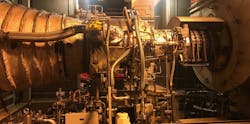Case Study on University Campus Cogeneration – Continually Striving for Energy Success at UIC
Exclusive to Energy Tech
By Frank Murphy, Assistant Chief Operating Engineer, West Co-Gen Power Plant, University of Illinois Chicago
Introduction
The University of Illinois at Chicago (UIC) West Co-Gen plant produces power, steam, and chilled water for the campus and medical school. Equipment additions and improvements over the last two decades offer a guide for other commercial and institutional (C&I) facilities. UIC personnel continue to enhance system efficiency, reliability and safety. This article examines some of the most noteworthy actions.
Benefits of Co-generation
In the early 20th Century, central power plants came into their own with the development of alternating current transmission and distribution systems. Plants sprung up on the East Coast and then elsewhere. These facilities were a marvel of technology at the time, and by the middle of the century large coal-fired plants and then nuclear plants emerged, where just one facility could power perhaps a million homes. Central power facilities also served as the springboard for another industrial revolution by providing inexpensive and seemingly unlimited power to refineries, steel mills, chemical plants and many other large industries.
Of course, the coal plants were emitting enormous quantities of carbon dioxide (CO2), whose potential negative effects on the climate were not well understood at the time. The large CO2 emissions were, in considerable measure, a result of the relative inefficiency of the conventional power process. Even in a state-of-the-art coal-fired drum boiler with superheat and reheat, approximately 2/3 of the combustion energy is needed for the conversion of water to steam (latent heat). Most of this latent heat is lost in the steam condenser, and thus the most modern units have a net efficiency of only 35 percent or so. The maximum net efficiency of the most advanced ultra-supercritical units is only 45 percent.
In the power industry, the leading fossil-fuel technology has evolved to natural gas-fired combined cycle. In general, approximately 2/3 of the power at a plant is generated by the combustion turbine (essentially a stationary jet engine). This is known as the Brayton thermodynamic cycle. Turbine exhaust heat generates steam in the appropriately named heat recovery steam generators (HRSGs) to produce the remaining power. This process represents the Rankine thermodynamic cycle. Some modern combined cycle units have broken the 60 percent net efficiency ceiling.
But even in combined cycle power units, the steam’s latent heat is still lost in the condenser. Enter co-generation/combined heat and power (CHP) technology. Co-generation net efficiencies of 80 percent are possible because the technology recovers much of the steam’s latent heat. CHP continues to increase in popularity (now accounting for 7 percent of U.S. electrical production) across a broad spectrum of industries per these efficiency benefits and corresponding CO2 emissions reductions. Other benefits include:
Reliability: Co-gen reduces reliance on the grid and mitigates the impact of outages. Co-gen fits into the category of distributed power generation.
Economic Benefits: CHP can provide a hedge against fluctuating electrical costs. At plants with gas turbine/HRSG redundancy, units can be started during times of peak demand and potentially save the plant from large electrical charges by outside utilities. At times the plant may provide electricity to the grid.
The United States Department of Energy (USDOE) has prepared a comprehensive portfolio of activities that focuses on the development of microgrids to further improve the reliability and resiliency of the country’s primary grids. In that vein, since 2001 the DOE has funded the UIC Energy Resources Center to help promote co-generation/CHP, and to assist Midwestern companies and institutions in evaluating CHP opportunities. Now we will look at some specific UIC activities.
History of UIC and the West Co-Gen Plant
UIC was founded in the 19th Century as a group of private health colleges. The first college, the Chicago College of Pharmacy, opened in 1859. Per subsequent growth and program enhancement, UIC reached Carnegie Research 1 status in 1987. In 2000, UIC significantly expanded campus size and student offerings. Today, enrollment is nearly 30,000 students, with the largest medical school in the country.
The extensive campus and medical facilities require substantial quantities of heating steam and chilled water for cooling. For many years, steam at the UIC West steam plant (pictured) was produced by six 1950s vintage Babcock &Wilcox boilers. This plant services the west side of the UIC campus and the two hospitals. It also provides chilled water for the West campus and one of the two campus hospitals.
Units 1-3, commissioned in 1950, were originally designed for coal but were converted to oil and then retired when the co-gen units came on line in 2000. Units 4 and 5 were built in 1958, and Unit 6, capable at the time of burning either oil or gas, was installed in 1976.
Now all natural-gas fired, the units have maximum steam outputs of 63,000, 95,000, and 95,000 lb/hr, respectively. The plant also has a five-year-old gas-fired Victory boiler (180,000 lb/hr maximum steaming rate) that provides capacity and backup during the cold winter months. Two decades ago, the plant became truly co-generational with the addition of three natural gas-fired Solar Turbines (also pictured in the image gallery), each capable of 7-MW power production. The turbine exhaust gases power three heat recovery steam generators (HRSGs).
During normal operation, each HRSG can produce 30,000 lb/hr of steam, but the steaming rate can be increased to 120,000 lb/hr with duct firing. Superheated steam (430–450°F) at 143–145 psig is provided to an inlet header, which then feeds the distribution lines to the campus. All steam is for direct heating. Much of the condensed steam is recovered, with a maximum condensate return of around 85 percent.
Chiller equipment consists of seven York Chillers, with three 2,500-ton-capacity units and four 2,000-ton machines. System volume is 700,000 gallons, and the chillers feed the entire campus except for one of the two hospitals.
Three 5-MW Wartsila natural gas-fired reciprocating engines provide additional power, with five diesel generators (four for the hospital, and one for the co-gen plant) as emergency backups. A recently installed black start generator also provides the capability to operate in island mode.
Methods to Ensure Success
From a management standpoint, key activities at UIC that ensure reliable and safe plant operation include:
· Full commitment from university leaders
· Understanding that many plant improvement projects are ongoing and need consistent funding to be successful.
· Open communication between management and plant staff
· Clear definitions of the authority and responsibilities of plant personnel
· Ensuring that personnel are qualified and trained.
Among these items, proper staffing and personnel training are essential. At UIC, although full staffing is at times a challenge (which many companies are now experiencing due to the COVID pandemic), the quality of UIC plant personnel has been excellent. In part, this is due to a local state-of-the-art training facility at the International Union of Operating Engineers Local 399. Trainees can obtain an Associate’s degree in Facilities Engineering Technology that is accredited by the state university system, and with further study can receive a bachelor’s degree in Industrial Technology and Management sponsored by the Illinois Institute of Technology.
Regarding integrated communication, UIC recently merged the Facilities and Utilities Departments, with the goal of developing a standardized water treatment program for the entire campus, and to provide coordinated investigations of and solutions to issues that could otherwise cause difficulties.
From a technical perspective, with the assistance of ChemTreat, Inc., water/steam chemistry training has become a daily activity and integral part of plant operation. Impetus has come from the understanding that poor chemistry control or operation of makeup water and condensate-return treatment systems can introduce impurities to steam generators that cause corrosion and scale formation.
Listed below are several important design and process modifications that UIC personnel have enacted to improve operation.
Makeup Water System
Upgrade of the original makeup water sodium softeners to reverse osmosis (RO). Sodium softeners only remove hardness ions, and allow all other ions to enter the boilers. Lower-pressure boilers can tolerate some dissolved solids, but at the least blowdown rates must be substantial to prevent excess solids accumulation and accompanying corrosion or steam carryover. RO reduces all impurities to very low concentrations.
Condensate Return Polishing
As previously noted, up to 85 percent of the steam supplied to the campus and hospitals comes back as condensate. Because the condensate return system is very extensive with miles of piping, the condensate can accumulate impurities such as metal corrosion products and hardness ions. The system is equipped with ion exchange polishers to remove these contaminants. Part of this program includes upgraded iron monitoring techniques to evaluate condensate return system corrosion. [1]
Enhanced Feedwater Chemistry Control
A phenomenon that has become quite concerning in utility steam-generating circuits is flow-accelerated corrosion (FAC). The first observed FAC failure occurred in a nuclear plant feedwater system in 1986, and resulted in four fatalities. [2] Other power plant feedwater/economizer failures over the years have caused additional deaths and injuries. FAC can also occur in lower-pressure steam-generating systems, and even though the effects do not appear to be as severe as in power units, should not be ignored. UIC personnel have made a concerted effort to establish steady feedwater chemistry within recommended guidelines for their units to minimize FAC.
Apart from these chemistry improvements, other companies that UIC works with to improve reliability and safety include firms specializing in non-destructive evaluations (NDE) of tube and vessel wall thickness, metallurgical analyses, boiler chemical cleaning and hydro blasting, and piping design modifications.
Continuing Efforts
Challenges never disappear at facilities of this size and complexity, and the following discussion outlines additional studies or projects underway. Potential solutions are also included.
· HRSG Thermal Fatigue: Thermal fatigue is common in units that frequently cycle on and off. A proposed solution at UIC is installation of a mud drum heater on each unit, which consists of a serpentine tube bundle supplied with steam from another unit. This equipment offers excellent standby and layup protection by keeping the boiler hot to minimize air ingress, and with a steam blanket on the vapor side.
· Improved Shutdown Procedures and Layup Chemistry: Apart from maintaining heat on idle units as described above, additional actions are often required to protect units from air ingress and oxygen attack during layup. UIC has been working with ChemTreat to optimize treatment chemical concentrations prior to shut down. From an operational standpoint, guidelines for shutdown cooling and startup heating rates should be closely followed to minimize mechanical and chemical stresses.
· Chemical Cleaning: Even with well-established water/steam chemistry treatment programs, over time steam generators will accumulate deposits that impede heat transfer and establish sites for under-deposit corrosion on boiler tubes. UIC is formulating plans for the chemical cleaning of the three HRSGs. Any chemical cleaning must be carefully planned and executed, but the procedure can often be more complicated with HRSGs due to the unusual tube geometries as compared to conventional boilers. Coordination with a reputable cleaning firm is a must for these projects.
· FAC Control: Besides improved feedwater chemistry control, UIC personnel have employed outside NDE contractors to evaluate piping for FAC. Several damaged locations have been located, however, none are at a crisis level yet. UIC plans further testing to obtain comprehensive results.
· Vent Steam: Installed a main steam header vent and silencer to discharge excess steam during peak electrical demand, but reduced campus steam requirements. This arrangement saves a considerable sum in purchased power.
Conclusion
This article briefly outlined several of the complexities that institutions like UIC face when managing a complex co-generation water/steam chemistry network. The institution’s philosophy is that funds invested upfront to maintain system reliability, efficiency, and safety are paid back many times over as compared with allowing equipment to operate until failure. Furthermore, optimizing efficiency reduces environmental impacts from unnecessary CO2 emissions.
About the author: Frank Murphy is an Assistant Chief Engineer at UIC’s West CoGen Steam Plant. He has more than 40 years of experience in steam plant operation beginning as a Boiler Technician in the U.S. Navy and including more than a dozen years in the power industry at Boyle Energy Services and Technology, Inc.
(Contributing Editor is Brad Buecker, longtime expert on steam generation issues).
Footnotes:
1. B. Buecker, F. Murphy, and K. Kuruc, “Iron Monitoring in Industrial Steam Generating Systems”; Water Technology, Jan/Feb 2021.
2. Guidelines for Control of Flow Accelerated Corrosion in Fossil and Combined Cycle Plants, EPRI Technical Document 3002011569: The Electric Power Research Institute, Palo Alto, California: 2017.





